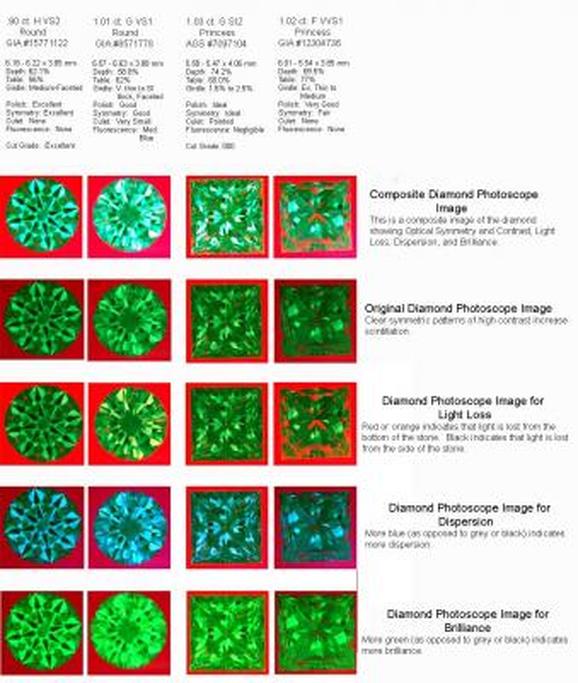The diamond photoscope helps you assess the beauty of a diamond
THE PHOTOSCOPE ALLOWS YOU TO SEE LIGHT LEAKAGE AND LIGHT LOSS FROM A DIAMOND

Our Diamond Photoscope Instrument Lets You Clearly Assess the Optical Qualities of Any Diamond
How would one know just how a particular diamond fares on the four qualities that together reveal the beauty of a diamond? These qualities are:
Light loss
Light entering a diamond can be lost out the bottom or the sides of the stone. Light loss should be minimal.
Brilliance (light returned to the eye as white light)
Brilliance should be high but balanced with Dispersion. Brilliance has two components. These are brightness and pattern/contrast. Brightness is self evident. Pattern is the arrangement of light and dark areas that come from internal and external reflections. Contrast is the relief of light and dark areas that creates the face up pattern of a diamond. Symmetric contrast and optical symmetry are important for Scintillation.
Dispersion (light returned to the eye as flashes of rainbow color or "fire")
Dispersion should be high but balanced with Brilliance. Brilliance and Dispersion are somewhat inversely related. That is, when a diamond is cut to increase Brilliance it will lose some Dispersion. Conversely, when a diamond is cut to increase Dispersion it will lose some Brilliance. The diamonds with the best cuts have a nice balance of white light and flashes of rainbow color.
Scintillation
This is the intense sparkles from the small areas of light that flash on or off as the diamond, the observer or lighting moves. Symmetric contrast and optical symmetry, for example, the Hearts and Arrows patterns, are needed for high scintillation.
Our proprietary instrument, the Diamond Photoscope, can give clear and repeatable feedback on these four optical qualities for any diamond. This is a proprietary instrument that has taken years to develop. The Diamond Photoscope captures the light returned by any diamond and generates highly accentuated images of light loss, brilliance, dispersion, scintillation (optical symmetry and symmetric contrast). A composite image is also generated. It is many times easier to see and assess these qualities from the Diamond Photoscope images than by just viewing the stones themselves.
Here are some examples:
We would draw the following conclusions about each stone based on the Photoscope images. The characteristics indicated by the Photoscope images can actually be seen in each stone.
0.90 ct Round Brilliant Cut H VS2
Some amount of light lost through the bottom of the stone
Little light lost through the sides of the stone
Strong brightness
Strong pattern
Strong contrast
Strong optical symmetry
Strong dispersion
Strong brilliance
1.01 ct Round Brilliant Cut G VS1
Some amount of light lost through the bottom of the stone
Some amount of light lost through the sides of the stone, especially near the center of the stone
Relatively strong brightness
Weak pattern
Weak contrast
Weak optical symmetry
High dispersion
Relatively strong brilliance
1.03 ct Princess Cut G SI2
Low level of light lost through the bottom of the stone
Some light lost through the sides of the stone
High dispersion
High brilliance
Medium contrast
Strong pattern
Relatively strong optical symmetry
1.02 ct Princess Cut F VVS1
Large amount of light lost through the bottom of the stone
Fairly large amount of light lost through the sides of the stone
Low level of dispersion
Low level of brightness
Low level of brilliance
Poor contrast
No clear pattern
Low level of optical symmetry
The Diamond Photoscope can help you to further assess and understand the optical qualities of the stones that you are considering for purchase. If you want a Super Ideal Cut round brilliant diamond it can let you see what the optical differences are between several Super Ideal Cut stones. If you want a fancy shape diamond (Princess Cut, Cushion Cut, Marquise, etc.) it can show which stones have the least light loss and the most brilliance, dispersion and scintillation
How would one know just how a particular diamond fares on the four qualities that together reveal the beauty of a diamond? These qualities are:
Light loss
Light entering a diamond can be lost out the bottom or the sides of the stone. Light loss should be minimal.
Brilliance (light returned to the eye as white light)
Brilliance should be high but balanced with Dispersion. Brilliance has two components. These are brightness and pattern/contrast. Brightness is self evident. Pattern is the arrangement of light and dark areas that come from internal and external reflections. Contrast is the relief of light and dark areas that creates the face up pattern of a diamond. Symmetric contrast and optical symmetry are important for Scintillation.
Dispersion (light returned to the eye as flashes of rainbow color or "fire")
Dispersion should be high but balanced with Brilliance. Brilliance and Dispersion are somewhat inversely related. That is, when a diamond is cut to increase Brilliance it will lose some Dispersion. Conversely, when a diamond is cut to increase Dispersion it will lose some Brilliance. The diamonds with the best cuts have a nice balance of white light and flashes of rainbow color.
Scintillation
This is the intense sparkles from the small areas of light that flash on or off as the diamond, the observer or lighting moves. Symmetric contrast and optical symmetry, for example, the Hearts and Arrows patterns, are needed for high scintillation.
Our proprietary instrument, the Diamond Photoscope, can give clear and repeatable feedback on these four optical qualities for any diamond. This is a proprietary instrument that has taken years to develop. The Diamond Photoscope captures the light returned by any diamond and generates highly accentuated images of light loss, brilliance, dispersion, scintillation (optical symmetry and symmetric contrast). A composite image is also generated. It is many times easier to see and assess these qualities from the Diamond Photoscope images than by just viewing the stones themselves.
Here are some examples:
We would draw the following conclusions about each stone based on the Photoscope images. The characteristics indicated by the Photoscope images can actually be seen in each stone.
0.90 ct Round Brilliant Cut H VS2
Some amount of light lost through the bottom of the stone
Little light lost through the sides of the stone
Strong brightness
Strong pattern
Strong contrast
Strong optical symmetry
Strong dispersion
Strong brilliance
1.01 ct Round Brilliant Cut G VS1
Some amount of light lost through the bottom of the stone
Some amount of light lost through the sides of the stone, especially near the center of the stone
Relatively strong brightness
Weak pattern
Weak contrast
Weak optical symmetry
High dispersion
Relatively strong brilliance
1.03 ct Princess Cut G SI2
Low level of light lost through the bottom of the stone
Some light lost through the sides of the stone
High dispersion
High brilliance
Medium contrast
Strong pattern
Relatively strong optical symmetry
1.02 ct Princess Cut F VVS1
Large amount of light lost through the bottom of the stone
Fairly large amount of light lost through the sides of the stone
Low level of dispersion
Low level of brightness
Low level of brilliance
Poor contrast
No clear pattern
Low level of optical symmetry
The Diamond Photoscope can help you to further assess and understand the optical qualities of the stones that you are considering for purchase. If you want a Super Ideal Cut round brilliant diamond it can let you see what the optical differences are between several Super Ideal Cut stones. If you want a fancy shape diamond (Princess Cut, Cushion Cut, Marquise, etc.) it can show which stones have the least light loss and the most brilliance, dispersion and scintillation
THE DIAMOND SPECIALISTS, INC. |
COMPANY REVIEWS |
SUPPORT |
SOCIAL MEDIA |
THE DIAMOND SPECIALISTS, INC.
Kaimuki Municipal Parking Lot
1123 11th Avenue, Suite 405
Honolulu, Hawaii 96816
Phone: (808) 739-0009
Email: [email protected]
Kaimuki Municipal Parking Lot
1123 11th Avenue, Suite 405
Honolulu, Hawaii 96816
Phone: (808) 739-0009
Email: [email protected]
© COPYRIGHT 2015. THE DIAMOND SPECIALISTS, INC.
ALL RIGHTS RESERVED.
ALL RIGHTS RESERVED.






